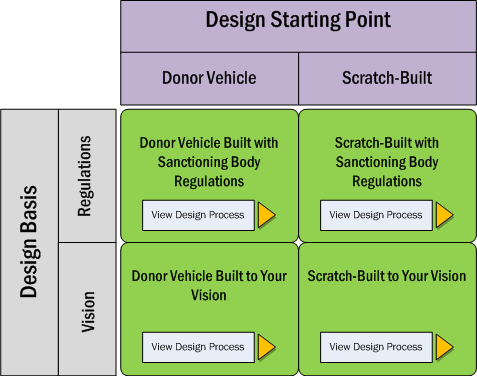Designing Your Own Race Car, Sports Car or Off-Road Truck
Designing your own vehicle, even if you don’t build it, can be a very rewarding experience. You’ll learn a lot about how cars work and if you do build it, you’ll be part of a select group of people who’ve taken on the challenge of building their dream.
Once you choose the type of vehicle you’re interested in, it’s time to begin thinking about how your vehicle is going to look, perform and cost.
Vision/Concept
Car design is a process that begins with a vision or concept of the vehicle to be created. Much like production vehicle design, DIY car design seeks to define goals and objectives for the design. In passenger vehicles, the objectives are usually around price, acceptable performance and safety and satisfying the transportation needs of the target market.
Common Race or Performance Vehicle Objectives
For racing cars, the objectives are much more oriented toward pure performance. The primary objectives of most race cars or performance cars are:
- Maximum acceleration and deceleration
- Maximum cornering speed
- Driver/occupant safety
- Cost of the final product
Almost every objective you can dream up will relate to performance, cost, safety or aesthetics. Regardless of how important you believe an objective to be, it should be included for your consideration as it is in the details that a good design becomes great.
Sanctioning Body Regulations
If you are planning to participate in a sanctioned race series, the regulations published by the sanctioning body will also form part of the vision for the race vehicle. Although regulations are often seen as limitations, they should also be seen as opportunities, assuming there is leeway in the interpretation of them.
Example Objectives/Vision Statements
Let’s consider some example objectives and vision statements:
- Total Parts Cost to remain below $10,000 (Vision/objective)
- Track width front not to exceed 72 inches (Regulations)
- Tires restricted to Greatrich XZ100 series (Regulations)
- Total vehicle weight not to exceed 1300 lbs (Regulations)
- Center of Gravity reduced 2″ from last year’s car (Vision/Objective)
- Side impact protection sustain 80 mph impact (Vision/Objective)
- Sleek, Flowing, Curving bodywork (Vision/Objective)
Once you have defined and documented the vision for the car then you will have a baseline of concepts and specifications to design from.
To assist you in documenting your vision and objectives we have prepared a Conceptual Drawing Template and a Component Worksheet document which are available as free downloads. The conceptual drawing can help you define the look/layout of your vehicle, while the Component Worksheet can help record the objectives/vision/regulations for each component in your car design.
Design Process
The Design of a vehicle is an iterative process where you attempt to meet all objectives you have defined. In practice, you usually won’t meet all of them, but hopefully most.
If you are designing a car from a donor car chassis, your process will involve determining how the vehicle components can be changed to meet your vision/objectives. If you are designing from scratch, your process will involve the design and selection of components from the rubber on the road on up.
Iterations
Car design is iterative (that is, requiring repeated re-designs) because with the exception of a few parts on a car, all parts attach to another in some way.
To illustrate, let’s picture a wheel on a race car. The wheel attaches to a tire and it also attaches to a wheel hub. If I decide to change the wheel from a 4 bolt by 4″ bolt circle to a 5 bolt by 5″ bolt circle, I’ll need to change the wheel hub as well. Now let’s say that wheel is no longer available in the size we need to fit the tire. I’ll need to change the tire as well. Further, what happens if the new wheel hub doesn’t fit the spindle I have? I’ll need to change it too and so on…
As you can see, changing one part can affect many parts “upstream” and “downstream” from that one part which is why we need to “Iteratively” design by going back and re-designing around a changed part.
The process itself is really not that complicated, but it does require some patience if you are scratch-building. Donor car builders will find their job a little easier in that the components the car comes with usually limit the design options and therefore the number of iterations necessary to get the best design possible.
Design Process Variations
Depending on whether you are starting from scratch or a donor car (The “Design Start point”) or are designing with sanctioning body regulations or your own vision (The “Design Basis”), there are four possible variations in the car design process.
In the diagram below is a matrix of the four variations. Click on the “View Design Process” to view the design process variation that matches your chosen vehicle type.

